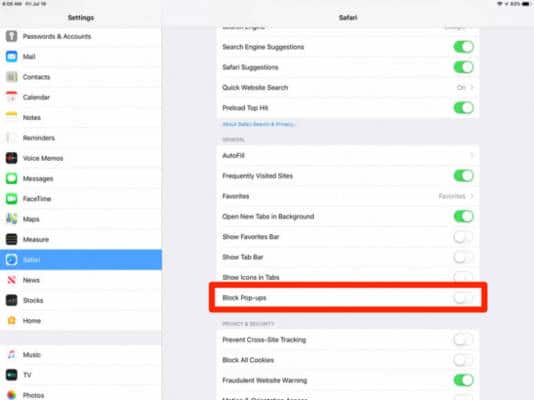Your iPad comes with a comfortable feature that enhances your web browsing experience. This feature is known as a pop-up blocker and its job is to block several types of pop-up windows from getting visible over web pages in Safari.
The pop-up blocker is enabled by default, and most times, that is precisely how you want it to be. However, there could be situations that will warrant allowing pop-ups. Some sites depend on pop-up windows to function properly, especially financial sites by banks.
Other websites make use of pop-ups to prompt you to register for services like newsletters. If you need to register, the pop-up might need to be seen.
Luckily for you, on your iPad, pop-ups can easily be allowed, it will only take a few clicks. It is actually impossible to select a list of websites that you wish to always allow pop-ups for, therefore you will have to deactivate the pop-up blocker for all web browsing. We advise you to allow pop-ups temporarily when it is needed and then re-enable it when you are through.
How Can I Allow Pop-ups On My iPad?
- Launch the Settings application.
- In the pane on the left, click “Safari.”
- Under “General,” disable “Block Pop-ups” by scrolling the switch to the left.

You Might Also Want To Read- How To Download Netflix Movies And Series On Your iPad To Watch With No Internet?
You just allowed pop-ups in Safari, and it will remain like that until you get back to Settings and activate it again. To activate it, simply scroll the switch back to the right.
More Information About Your iPad
iPad is a line of tablet computers designed, developed and marketed by Apple Inc., which run the iOS and iPadOS mobile operating systems. The first iPad was released on April 3, 2010; the most recent iPad models are the sixth-generation iPad, released on March 27, 2018; the fifth-generation iPad mini, released on March 18, 2019; the third-generation iPad Air, released on March 18, 2019; and the 11-inch (280 mm) and third-generation 12.9-inch (330 mm) iPad Pro, released on November 7, 2018.
As of May 2017, Apple has sold more than 360 million iPads, though sales peaked in 2013. It is the most popular tablet computer by sales as of the second quarter of 2018.
The user interface is built around the device’s multi-touch screen, including a virtual keyboard. All iPads can connect via Wi-Fi; some models also have cellular connectivity. iPads can shoot video, take photos, play music, and perform Internet functions such as web-browsing and emailing. Other functions – games, reference, GPS navigation, social networking, etc. – can be enabled by downloading and installing apps. As of March 2016, the App Store has more than million apps for the iPad by Apple and third parties.
There have been nine versions of the iPad. The first generation established design precedents, some of which have persisted through all models. The 2nd-generation iPad (iPad 2) introduced a new thinner design, a dual-core Apple A5 processor, and VGA front-facing and 720p rear-facing cameras designed for FaceTime video calling. The third generation added a Retina Display, the new Apple A5X processor with a quad-core graphics processor, a 5-megapixel camera, HD 1080p video recording, voice dictation, and 4G (LTE). The fourth generation added the Apple A6X processor and replaced the 30-pin connector with an all-digital Lightning connector. The iPad Air added the Apple A7 processor and the Apple M7 motion coprocessor, and reduced the thickness for the first time since the iPad 2. The iPad Air 2 added the Apple A8X processor, the Apple M8 motion coprocessor, an 8-megapixel camera, and the Touch ID fingerprint sensor; and further reduced the thickness. The iPad introduced in 2024 added the Apple A9 processor, while sacrificing some of the improvements the iPad Air 2 introduced in exchange for a lower launch price. In 2018, Apple released a 2018 model of iPad with Apple A10 Fusion processor and Apple Pencil support. A year later, the 2019 iPad Air is released, with 10.5-inch display and Apple A12 chip.
There have been five versions of the iPad Mini, all of which have a screen size of 7.9 inches (20 cm). The first generation has similar internal specifications to the iPad 2 but uses the Lightning connector instead. The iPad Mini 2 added the Retina Display, the Apple A7 processor, and the Apple M7 motion coprocessor, closely matching the internal specifications of the iPad Air. The iPad Mini 3 added the Touch ID fingerprint sensor. The iPad Mini 4 features the Apple A8 and the Apple M8 motion coprocessor. The 5th generation features the Apple A12 SoC.
There have been three generations of the iPad Pro. The first generation came with 9.7″ and 12.9″ screen sizes, while the second came with 10.5″ and 12.9″ sizes, and the third with 11″ and 12.9″ sizes. The iPad Pros have unique features such as the Smart Connector, which are exclusive to this series of iPads.

